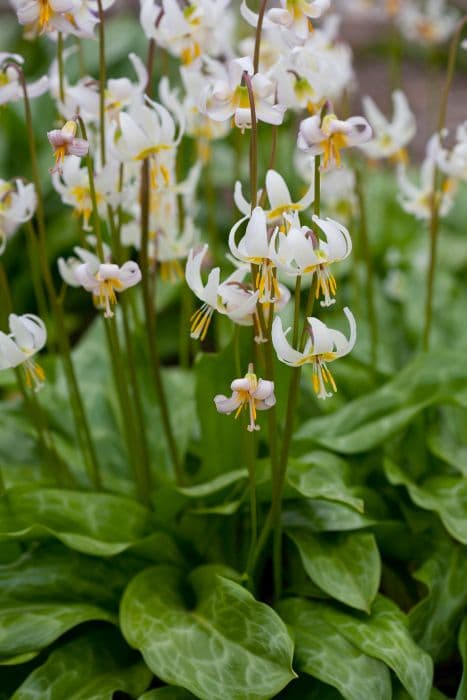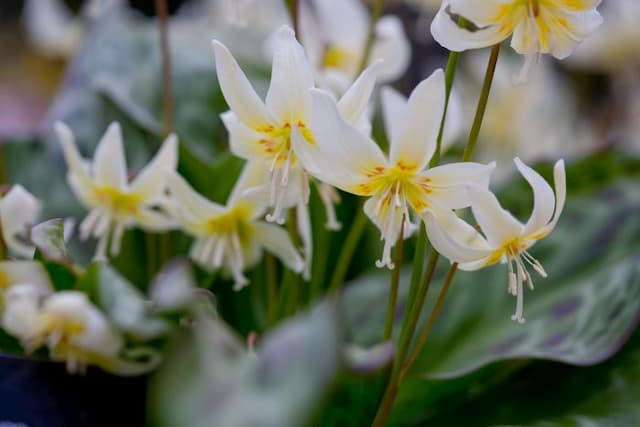Tulip Tulipa 'Red Shine' (6)

ABOUT
Tulipa 'Red Shine' is a striking variety known for its vibrant, glossy appearance. It displays a classic tulip shape with a slender stem topped by a single large, cup-shaped flower. The petals of 'Red Shine' have a luscious deep red hue that gleams as if polished, giving the flower a luxurious sheen that catches the eye. The petals may show a hint of maroon at the base, further enhancing the richness of the coloration. The leaves are typically a rich green, providing a lovely contrast to the red blossoms and are usually lance-shaped, forming an elegant foliage cluster at the base of the stem. As the plant matures, the flower opens to reveal a black and yellow center, which adds a dramatic touch to the overall appearance of the tulip. This variety is celebrated for its bold and elegant presence in any garden display.
About this plant
 Names
NamesFamily
Liliaceae
Synonyms
Red Shine Tulip
Common names
Tulipa 'Red Shine'
 Toxicity
ToxicityTo humans
The plant commonly known as tulip is generally considered to have low toxicity to humans. However, ingesting parts of the tulip, such as the bulbs, can cause symptoms like nausea, vomiting, diarrhea, and dizziness. Touching the bulbs may also cause allergic skin reactions in some individuals. It is not usually considered life-threatening but consuming any part of a tulip can result in discomfort and should be avoided.
To pets
Tulips are toxic to pets, including cats and dogs. If a pet ingests any part of a tulip, particularly the bulb, they may experience symptoms like vomiting, diarrhea, hypersalivation, and depression. In severe cases, consuming large amounts of the bulb can lead to central nervous system depression, cardiovascular abnormalities, and even death. It is important to keep tulips out of reach of pets to prevent poisoning.
 Characteristics
CharacteristicsLife cycle
Perennials
Foliage type
Deciduous
Color of leaves
Green
Flower color
Red
Height
1-2 feet (30-60 cm)
Spread
0-1 feet (0-30 cm)
Plant type
Bulb
Hardiness zones
3-8
Native area
Central Asia
Benefits
 General Benefits
General Benefits- Enhances Garden Aesthetics: The Tulipa 'Red Shine', commonly known as Tulip, adds vibrant color and visual interest to gardens and landscapes.
- Seasonal Display: Tulips provide a colorful display in spring, marking the change of seasons and contributing to a diverse and dynamic garden environment.
- Pollinator Attraction: While not the top choice for pollinators, tulips can still attract bees and other beneficial insects to the garden, aiding in the pollination of other plants.
- Ease of Cultivation: Tulips are relatively easy to grow, making them suitable for gardeners of all skill levels.
- Symbolism and Tradition: Tulips often symbolize love and cheerfulness and are associated with traditional springtime celebrations such as Easter and Mother's Day.
- Variety: With a wide range of cultivars and colors, tulips can be selected to match any garden design or color scheme.
- Cut Flower Use: Tulips are popular cut flowers that can be used in floral arrangements, bringing the beauty of the garden indoors.
 Medical Properties
Medical PropertiesThis plant is not used for medical purposes.
 Air-purifying Qualities
Air-purifying QualitiesThis plant is not specifically known for air purifying qualities.
 Other Uses
Other Uses- The tulip bulbs of 'Red Shine' can be ground into flour and used as a substitute for starch in cooking and baking when food resources are limited.
- Tulip petals, including those from 'Red Shine', are edible and can be used to add a colorful flair to salads and desserts.
- The sturdy stems of the tulip can be used in floral crafts, such as making homemade paper or for creating natural dyes for fabrics.
- In traditional textile arts, 'Red Shine' tulip petals can be pressed and incorporated into eco-printing processes to transfer their color and shape onto fabric.
- The plant's leaves can be used to create a natural green pigment for art, by crushing and processing them into a paste or liquid form.
- Tulip 'Red Shine' bulbs can be carved and used as stamps for crafting or decorative purposes, printing their unique silhouette onto various materials.
- The vibrant red color of 'Red Shine' petals can be used in potpourri to add visual appeal and a light, floral fragrance to rooms.
- During the blooming period, 'Red Shine' tulips can function as a natural pest deterrent in gardens, as certain pests tend to avoid them.
- Used as a colorful, biodegradable confetti alternative, 'Red Shine' petals can add a festive touch to outdoor celebrations with less environmental impact.
- 'Red Shine' tulips can be incorporated into educational settings as a tool for teaching botany, plant biology, and horticulture practices.
Interesting Facts
 Feng Shui
Feng ShuiThe Tulip is not used in Feng Shui practice.
 Zodiac Sign Compitability
Zodiac Sign CompitabilityThe Tulip is not used in astrology practice.
 Plant Symbolism
Plant Symbolism- Love - The Red Tulip, often associated with true love, derives its symbolism from a Turkish legend about star-crossed lovers.
- Passion - Its vibrant red color embodies feelings of deep passion and desire.
- Perfect Love - Traditionally, the Red Tulip is a declaration of perfect, undying love, symbolizing a heart that's aflame with affection.
- Belief in Love - Giving a Red Tulip can be an expression of a strong belief in the love you share with someone.
- Eternal Love - In some cultures, Red Tulips are associated with eternal love, surpassing even death.
- Fame - Besides love, Red Tulips can also symbolize fame and being perfect in the eyes of a loved one.
 Water
WaterThe Red Tulip should be watered thoroughly when the soil feels dry to the touch. During the active growth in the spring, water once a week with about a half gallon for each bulb to ensure the soil is moist but not waterlogged. Reduce watering after the flowering period as the foliage begins to die back, signaling the end of the growing season. Water sparingly during this time, just enough to prevent the soil from completely drying out. During the dormant period in the summer, after the leaves have died back, watering should be stopped altogether.
 Light
LightRed Tulips require full sun exposure for optimal growth, which means they should receive at least 6 hours of direct sunlight daily. The best spot for planting them is in a location where they are not shaded by larger plants or trees and are exposed to the full morning and early afternoon sun. They can tolerate light afternoon shade, especially in regions with very hot summers.
 Temperature
TemperatureRed Tulips thrive in a temperate climate with a preferred temperature range between 60°F and 70°F during their growth period. They can withstand winter minimums down to about 20°F, which is essential for their dormancy and subsequent spring blooming. During the hot summer months, you need not worry about temperature as they are dormant, although extremely high temperatures over 90°F can sometimes affect bulb survival.
 Pruning
PruningPruning Red Tulips involves deadheading the flowers once they have faded, which helps to direct the plant's energy back into the bulb for next year's growth. Prune the stems down to the foliage level, but leave the leaves intact. The best time for pruning Red Tulips is when the flowers have finished blooming, typically late spring or early summer. The foliage should be left to die back naturally and should only be removed once it has turned yellow and comes away easily.
 Cleaning
CleaningAs needed
 Soil
SoilThe best soil mix for the Red Tulip or 'Red Shine' Tulip is a well-draining, sandy or loamy soil with a pH between 6.0 and 7.0. It is important to ensure the soil allows for proper drainage to prevent rot.
 Repotting
RepottingRed Tulips typically do not need repotting as they grow from bulbs that are planted annually. After blooming, the bulbs can be dug up and stored for the next season.
 Humidity & Misting
Humidity & MistingRed Tulips prefer moderate humidity levels but are generally adaptable to the ambient outdoor humidity in the regions where they can be grown.
 Suitable locations
Suitable locationsIndoor
Place Red Tulips in bright, indirect light and cool temperatures.
Outdoor
Plant bulbs in fall, full sun, well-draining soil.
Hardiness zone
3-8 USDA
 Life cycle
Life cycleTulip 'Red Shine' begins its life as a bulb, which is planted in the fall before the onset of winter. After a period of winter chilling, the bulb breaks dormancy in early spring, sending up shoots, leaves, and a single flower stem. The flower blooms for a brief period, typically a few weeks, during which it may be pollinated before the petals fall away. Once flowering is complete, the foliage remains, allowing the plant to photosynthesize and replenish the bulb's energy reserves. By early summer, the leaves yellow and die back as the plant enters dormancy. The bulb remains underground, where it divides and generates new bulbs, ready to begin the cycle again next spring.
 Propogation
PropogationPropogation time
Autumn
The most common method of propagation for the Tulip 'Red Shine' is through the division of bulbs. This variety of tulip is usually propagated in the fall, as the bulbs need a period of cold dormancy to stimulate spring growth. Gardeners typically lift the bulbs when the foliage has died back after flowering and the bulbs have had a chance to replenish their energy stores. The bulbs are then carefully separated, making sure that each offset or daughter bulb has a portion of the basal plate to ensure that it can grow into a new plant. These separated bulbs are then planted about 4 to 6 inches (approximately 10 to 15 centimeters) deep and 4 to 6 inches apart in well-draining soil, with the pointed end facing upward. They will then overwinter in the ground and emerge as new tulip plants in the spring.








